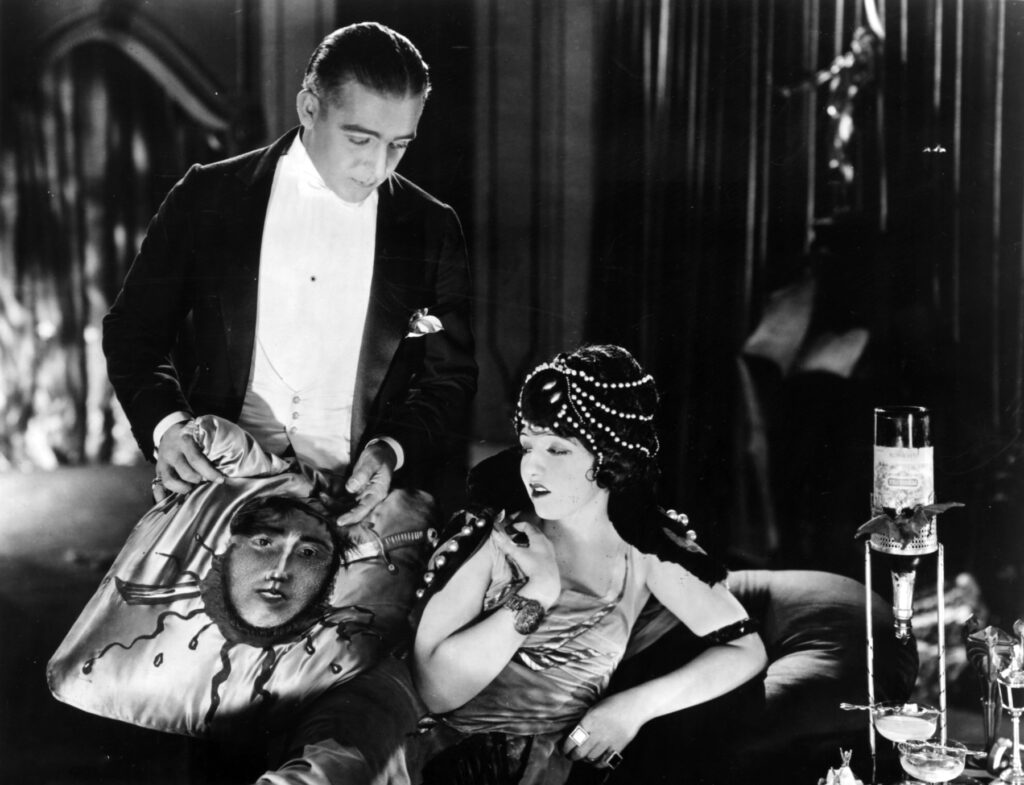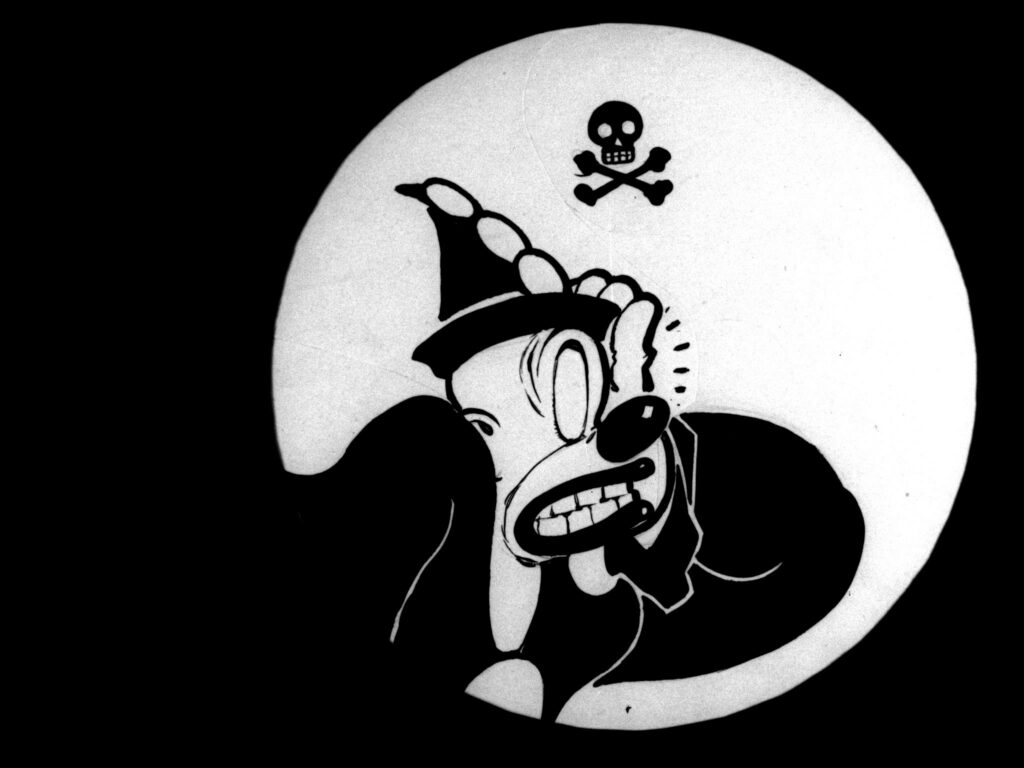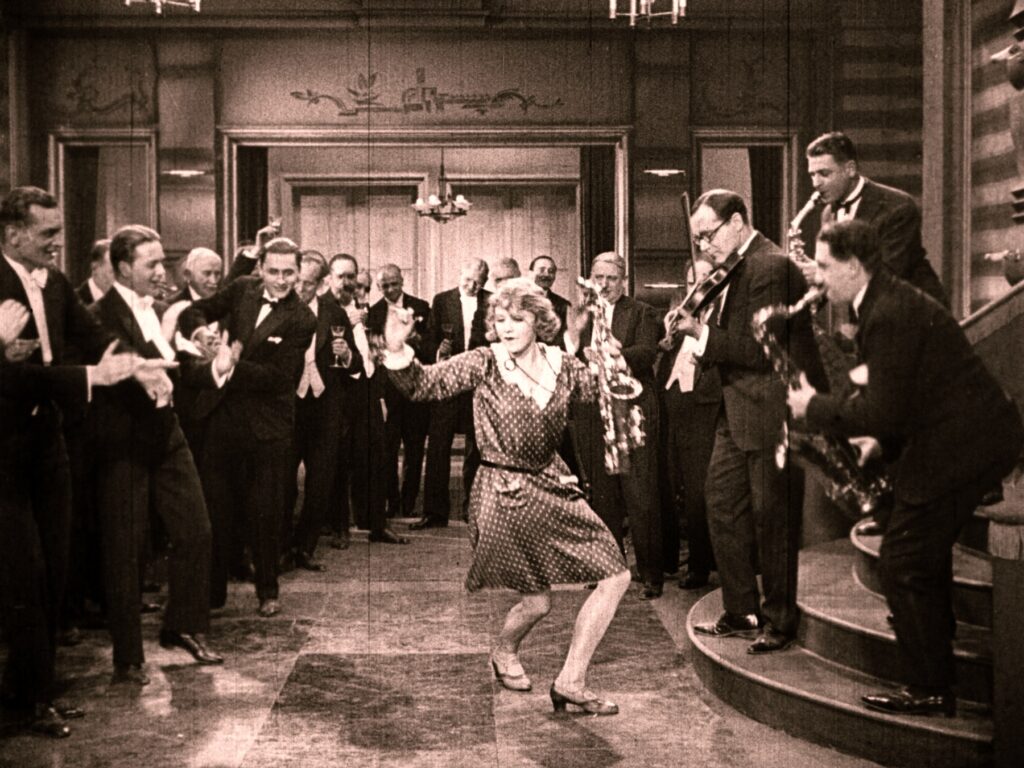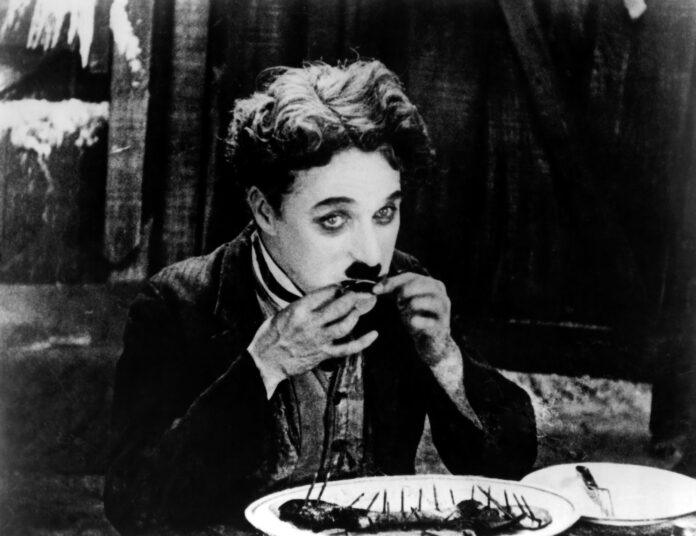The San Francisco Silent Film Festival (Wed/12-Sun/16) is back this week, once again being held in a preserved classic Art Deco movie palace—though perhaps not the one you’d expect. While the Orinda Theatre does not date from the silent era (it opened in 1941), it’s nonetheless one of the last of its kind in the Bay Area. In more recent years, two extra houses were added that do not detract from the original “big screen” dimensions, as they got carved from what had previously been adjoining retail space.
In any case, it’s the big house that’ll be hosting SFSFF, whose theoretical return to SF’s own Castro Theatre someday remains very much TBD. The additional schlepping you might be doing by car or BART to East Bay suburbia only makes it more attractive to stay for multiple consecutive programs, as many Silent Fest patrons are wont to do anyhow.
Things kick off the night of Wed/12 with The Gold Rush, one of the most lastingly famous and popular of all silents. It has writer-director-producer Charlie Chaplin’s “Little Tramp” figure as an unlikely would-be prospector in the Klondike, battling bears, bullies and blizzards. It was reckoned the fifth-most-successful film of the entire pre-talkie epoch, and apart from another Chaplin vehicle (The Circus) is the only one in that top 10 that’s not some sprawling dramatic epic. Although admittedly the opening sequence of innumerable trekkers on a frozen trail is quite spectacular in scale. Much ensuing action takes place in the pasteboard interior settings of a cabin and saloon, however, underlining this star’s roots as a music hall stage performer.
The Gold Rush was released exactly a century ago—as was the festival’s Sunday night closing selection from another multihyphenate comedic talent, Buster Keaton. While well-received at the time, Go West—in which his protagonist “Friendless” braves cattle-ranch life—was far from the major global cultural event Chaplin’s film comprised. It is difficult now to fathom just how vast “the Little Tramp’s” appeal was then, quite possibly more so than any screen luminary before or since. Yet today his rather Victorian sentimentality and moralizing can seem less appealing (or funny) than Keaton’s deadpan weathering of absurd, sometimes awe-inspiring slapstick situations. Audiences of 1925 might well have been baffled by the prediction that many future viewers would admire Chaplin… but love Buster Keaton.
Between those two entries from kings of silent humor, there’s myriad other features showing off Hollywood’s surviving pre-talkie riches. They include another Klondike tale, 1928’s The Trail of ’98, a big, energetic, expensive, reportedly arduous effort that supposedly cost six lives (lost via avalanche and drowning) during production. Delores del Rio and Ralph Forbes are the appealing romantic leads in an adventure melodrama whose script isn’t quite up to the level of the action setpieces…but those are stupendous. Clarence Brown would go on to direct numerous other classics, including National Velvet, The Yearling, and numerous Garbo vehicles. Then there’s The New Klondike, a 1926 seriocomedy from a Ring Lardner story that has the period’s agreeable if now little-remembered star Thomas Meighan. He’s a pro baseball player shipped for spring training to Florida—then, as now, depicted as a magnet for con artists. It was directed by Lewis Milestone, who’d soon win an Oscar for the first film version of All Quiet On the Western Front.

Cecil B. DeMille was just forging a name for himself as the “golden age’s” biggest brand-name director when he made The Affairs of Anatol, the last of several collaborations with the hugely popular Gloria Swanson. Her proper society wife takes a back seat here, however, to the struggles of husband Wallace Reid, as he’s distracted by old flame Wanda Hawley. She’s a once-good girl gone bad, thus sparking his desire to “rescue” her—though it’s clear she’s having too much fun to crave redemption. Also featuring Bebe Daniels as “Satan Synne,” whose occult den features a live leopard as pet, this 1921 hit predated DeMille’s Biblical epics. Still, it found him already in full possession of a clucking moral tone that characteristically allowed showing as much scantily-clad “decadence” as possible. Several years later he wore his producer’s hat for The Wreck of the Hesperus, a maritime melodrama inspired by Longfellow’s narrative poem. It’s one of several films in this year’s Silent Fest that were long thought lost, until discovery of extant materials allowed a restoration that will have its world premiere this week.
Another big spectacle is the 1926 version of much-filmed Foreign Legion adventure Beau Geste. It has long been overshadowed by the very close remake of 1939 with Gary Cooper, yet arguably this is that story’s finest screen incarnation. And much as we love Coop, no one was ever better suited to such stories than debonair, effortlessly noble Ronald Colman. That same year, imported Danish director Benjamin Christensen (still best known for the notorious Haxan aka Witchcraft Through the Ages) commenced his stint in Hollywood with The Devil’s Circus. It’s a Dickensian big top meller with a notably poignant ending, starring Norma Shearer and Charles Emmett Mack—the latter a promising young actor who’d die in a car crash just months after its release.
Similar if yea darker is another hit MGM release, Todd Browning’s 1927 The Unknown. “Man of a Thousand Faces” Lon Chaney portrays “Alonzo the Armless,” a deceptive carnival “wonder” driven to extreme acts by his furtive lust for lovely Nanon (Joan Crawford, disarmingly free of her later mannerisms). A contrastingly wholesome superstar of the era was silent cowboy king Tom Mix. Only a fraction of his nearly 200 westerns survive. But 1921’s Trailin’ is a good one, casting him as an aristocratic eastern youth with the spirit of a natural cowboy—inclinations eventually explained by secrets of his ancestry, of course. It’s exciting, with a better plot than most rote “oaters.”

A different category of stardom altogether was inhabited by Koko the Clown, the Fleischer Brothers’ original leading cartoon attraction. Eight of that antic figure’s shorts, imaginatively mixing animation and live action, will be brought together on one Koko! program. If you aren’t familiar with this prankish line-drawing pantomime, there’s a reason: Legal troubles the Fleischers were embroiled in during the early sound era forced Koko’s temporary “retirement,” causing them to introduce Betty Boop, who promptly and lastingly stole his thunder.
Outside the Hollywood orbit, independent producers did exist in the silent era, some attempting to establish regional studio and distribution networks catering to otherwise underserved audience demographics. The Flying Ace (1926) is the only feature known to have survived from Jacksonville, FL’s Norman Film Manufacturing Co., and like most of its product, this one features an “Entire Cast Composed Of Colored Artists.” They enact an intrigue involving aviation, stolen loot, and two rival pilots fighting over a bob-haired flapper. It depicts African-Americans as they would have liked to live: In a society where race doesn’t seem to be an issue, let alone a millstone.
But as ever, SF Silent Fest reaches well beyond the U.S. to encompass work from around the world. This year brings a program of three two-reeler “cases” from an extensive UK series starring stage actor Elie Norwood as a Sherlock Holmes even author Arthur Conan Doyle found ideal; the 1928 German Song, another circus-y melodrama, providing beauteous US import Anna May Wong with the title role; and a pre-Hollywood early (1920) Lubitsch joint, Kohlhiesel’s Daughters. Its rambunctious Alpine spin on The Taming of the Shrew is quite different from the sophisticated boudoir humor he was later associated with.
Some particular international highlights that we were able to preview:

Asphalt (1929)
An Austrian who like many in the German film industry left for the US once the Nazis came to power, Joe May was never again the major player in sound-era Hollywood that he had been during Europe’s silent years. His final effort in that latter role was this tangled romance between an upright young Berlin police officer and a jaded female thief who seduces him simply to avoid jail. Despite its “city symphony” aspects, the film was (remarkably) shot almost exclusively on studio sets, a testament to the extraordinary craft and resources of UFA at the time. Like Murnau’s Sunrise, it’s an example of highly evolved pure cinematic style elevating a very simple, moralizing story to the level of art.
Island Fisherman (1924)
Comparably raw, almost documentary-like in its convincing details of life in coastal Brittany—where society seems so timeless and self-contained, this story might easily be set two centries earlier—is Jacques de Baroncelli’s adaptation of a popular 1886 novel by Zola-like French realist author Pierre Loti. Charles Vanel (who three decades later would star in The Wages of Fear) is a sailor who falls for a demure villager (Sandra Milovanoff), eventually marrying her. But as in the immortal 1970s Top 40 hit “Brandy,” his real “life, my lover, my lady is the sea,” leaving his bride forever pining for the seaman’s return. Melancholy and poetical, restrained and touching, richly atmospheric, this ballad-like narrative is a find.
My Son (1928)
Revolutionary in both its stylistic innovations and overt propagandizing, Soviet cinema of the silent era seldom paid such scrupulous attention to ordinary human emotions as in this “lyrical etude in five parts” from director Evgenii Cherviakov. 18-year-old star Anna Sten would later become the object of a famously failed Hollywood star-making campaign. Here, she plays a woman compelled to inform her firefighter husband that “their” child was in fact fathered by another man during his long absence. Excluding all political rhetoric, focused almost entirely on the restrained intensity of performances in close-up, this is a major rediscovery that was long thought lost. Over a third of the original film remains MIA, alas. Yet the pieces that have been located and reassembled in recent years are still potent.
Master of the House (1925)
Before classics The Passion of Joan of Arc and Vampyr, Danish auteur Carl Dreyer made this startlingly forward-looking domestic drama, crafted in a mode less strikingly austere but just as impressive as his more famous later works. Based on a (different) play, it can be taken as a sort of commentary on Ibsen’s A Doll’s House, with focus this time on the thoughtlessly condescending household “master.” Viktor (Johannes Meyer) is a petty tyrant who treats his Copenhagen family like servants, oblivious to the sacrifices his wife (Astrid Holm) makes to preserve his comfort. When she’s persuaded to leave him for the sake of her wrung-out health, their longtime nanny (Mathilde Nielsen) takes charge—and she makes sure Viktor fully absorbs the consequences of his own cruel actions. Featuring a rare screen depiction of a man actually changing an infant’s diaper, this slow yet involving tale isn’t so much pro-feminist as anti-patriarchy. Here, it’s the husband as “shrew” who needs to be “tamed.”

Saxophone Susy (1928)
This Jazz Age spin on The Prince and the Pauper has Anny Ondra as a Baron’s high-spirited daughter yearning for a life on the stage—something her family will never allow. Instead, they pack her off to an academically strict boarding school. But en route she encounters a friend, the poor child of theatrical folk, who’s being sent to an English dance school. Realizing each would love to take the other’s place, they do just that, pulling a switcheroo that eventually makes “Susy” the toast of London’s smart set. Ondra is like a flapper Lucy Ricardo, performing lots of amusing physical comedy in a film that was so successful, the same star and director remade it just a few years later as a talkie. It would have made an ideal vehicle for Clara Bow, who seldom got material this good.
Song of the Scarlet Flower (1919)
Mauritz Stiller is now mostly remembered for “discovering” Greta Garbo and bringing her to America—where he was initially expected to have much the bigger career between the two of them. But the openly gay (at least in Europe) Swede was a significant director before his untimely 1928 death, the few surviving films revealing a major talent. Based on a famous 1905 novel that would be filmed again four times, this saga has Lars Hanson as a Peer Gynt-like handsome cad, blithely laying siege to a succession of robust rural women he seduces, then abandons. He is hard to resist, particularly when surfing rapids astride a log on a bet. But he is due a comeuppance, and the movie acquires its dramatic depth when that arrives, much thanks to the skill of actor and director. Hanson is so good here, you’ll wish you could see his Hamlet—his long career was spent largely on the stage, where he was particularly renowned as a Shakespearean.
As always, all 22 programs at this year’s Silent Fest will feature live musical accompaniment by a diverse range of instrumental ensembles and soloists. The San Francisco Silent Film Festival runs Wed/12 through Sun/16 at the Orinda Theater. For ticket, schedule, program and other information, go here.




